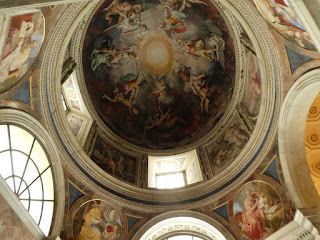At 10am there was hardly any queue at the entrance to the Roman Forum. It is a huge area with mixture of remains. It was a market place, a civic centre and a religious complex. This is the Temple of Antonius and Faustina - AD 141.
This is the temple of the heavenly twins Castor and Pollux after they supposedly led the Romans to victory in 496BC
The Vicus Lugarius is the original road which was created in the 5th & 6th centuries.
The Temple of Saturn was the city treasury with gold, silver and coins stored here.
The Umbilicus Urbis was the notional centre of the city and was also supposedly the place where the living world was in contact with the underworld.
We walked up the most central of Rome's seven hills and explored the Palatine Stadium, an area used by the Emperor for private games
After walking through extensive gardens and ruins, we reached the viewing balcony which gave fantastic views of the Forum and the modern city beyond.
This is the Arch of Titus built by the Emperor Domitian to honour his elder brother Titus.
We caught the Rome Metro to St. Peter's. There were lots of market stalls and vendors and it was a 10 minute walk to the walls of the Vatican City where we saw enormous crowds.
We joined a group for a tour of the Vatican Museum and the first view inside was of St. Peter's Dome.
It was extremely busy inside as the Museum as it would be closed the next day for a Papal audience. The Round Room is centred on this vast red basin made out of a single piece of red porphyry stone.
This gilded bronze statue of Hercules was the only bronze in the Vatican as all the others had been melted down for weapons.
This floor mosaic was exquisite.
The Map Room with its beautiful ceiling is 120 metres long and contains 40 huge topographical maps created between 1580 and 1583 for Pope Gregory XIII.
We were able to snatch a very quick view of the Pope's private garden.
We thought this domed ceiling was wonderful and understand that these rooms were the private apartments for Pope Julius II.
After this we visited the Sistine Chapel and it was amazing but we were not allowed to take photographs of it.
This is the Pope's special door into St. Peter's and it is opened just once a year.
St. Peter's Square was set out between 1656 and 1667 to a design by Bernini. The colonnades represent the motherly arms of the church. The 25m obelisk was brought to Rome by Caligula from Heliopolis in Egypt and was later used by Nero as a turning point for chariot races.
The square was laid out with thousands of chairs for the next day's Papal audience.
As we were leaving we caught sight of these two Swiss Guards, the personal soldiers of the Pope.
























No comments:
Post a Comment